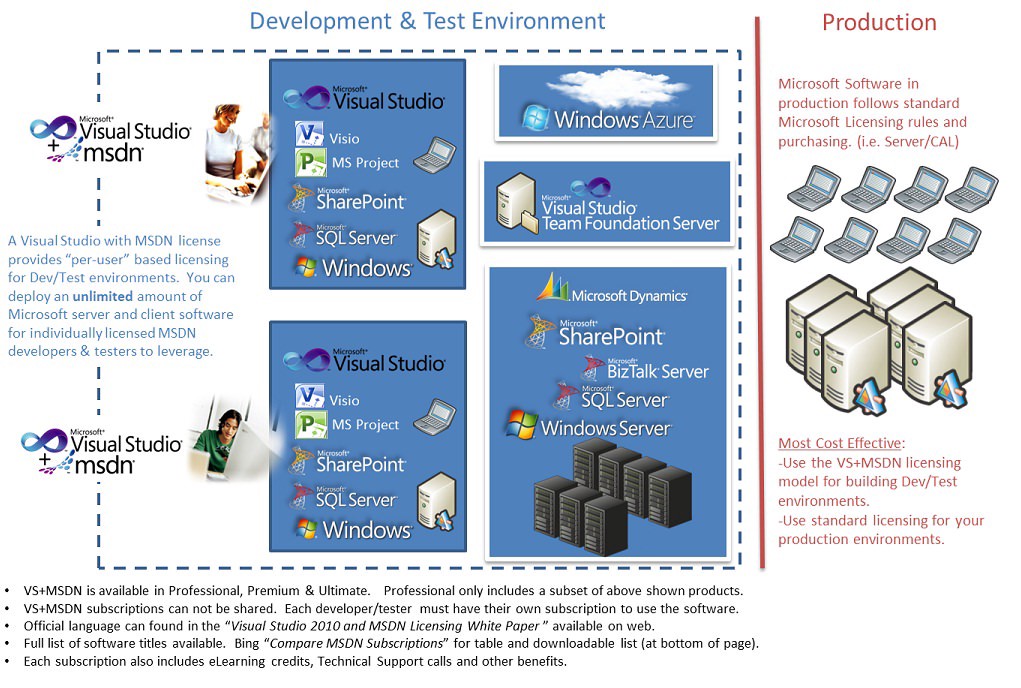The Microsoft Developer Network, better known as MSDN, now called Visual Studio Subscriptions, is one of Microsoft?s most misunderstood products. The Visual Studio Subscription (formerly MSDN) is one of the largest community platforms for developers working on Microsoft technologies.

What You Get in Your Visual Studio Subscription
With an MSDN subscription, you get all the software and benefits you need to stay up on all things code, including monthly cloud credits, collaboration tools, training perks, support, and more ? all the latest and greatest from Microsoft.
This also provides IT departments with a cost-effective way to license Microsoft software for individuals involved in the development and test process, but who do not require the full suite of Visual Studio development tools.
The subscription license gives a single user the ability to access/use any Microsoft Enterprise product for Dev/Test purposes (i.e. WinServer, SQL Server, BizTalk, SharePoint, Dynamics, etc, etc, etc). The list of software titles included depends on the level of your subscription.

Beyond giving a single developer user cool software? providing a Visual Studio Subscription for all of the Developer and QA team provides an efficient, per-user, license model for your entire Dev & Test environments. Adopting this model means you do not have to purchase any stand-alone Microsoft products for pre-production.

The Visual Studio Subscription licenses each user for unlimited installs and instances of the products on their local, shared and virtualized environments.
ref: unlimited dev test environments with msdn subscriptions

How much is a Visual Studio Subscription
A standard Visual Studio Enterprise subscription with MSDN costs $5,999 for the first year and $2,569 annually for renewals. VL customers get a discount, of course. An annual cloud subscription (with non-perpetual license) is a flat $2,999 per year. This is as of 2016 and subject to change.
Who can use the Software
Individual developers
Any individual developer can use Visual Studio Community to create their own free or paid apps. In addition, any number of users may use the software to develop and test device drivers for the Windows operating system.
Organizations ?
- An unlimited number of users within an organization can use Visual Studio Community for the following scenarios: in a classroom learning environment, for academic research, or for contributing to open source projects.
- Any number of users may use the software to develop and test device drivers for the Windows operating system.
- For all other usage scenarios: In non-enterprise organizations, up to 5 users can use Visual Studio Community. In enterprise organizations (meaning those with >250 PCs or > $1M in annual revenue) no use is permitted for employees as well as contractors beyond the open source, academic research, and classroom learning environment scenarios described above.
Individual User Licensing
Licensed are for Design, Development, Testing, and Demonstrating Your Programs
All Visual Studio subscriptions and Visual Studio Professional are licensed on a per-user basis. Each licensed user may install and use the software on any number of devices to design, develop, test, and demonstrate their programs. Visual Studio subscriptions also allow the licensed user to evaluate the software and to simulate customer environments in order to diagnose issues related to your programs. Each additional person who uses the software in this way must also have a license assigned to them.
ref: Visual Studio 2017 Licensing Whitepaper
Can Different Licensed Users Run the Same Software?
Yes. Each member of the development team that will use (install, configure, or access) the software must have his or her own Visual Studio subscription. Two or more individuals may use the same software if each has a Visual Studio subscription.
Examples:
A development team consists of 6 software developers, 1 architect/developer, and 3 testers. The team is building an in-house Web-based accounting system and wants to use the software to set up a test environment running Windows Server 2012 and Microsoft SQL Server 2014. If all 10 team members will be accessing the development or test environment, then each will require a Visual Studio subscription. The minimum subscription levels including both of these products are Visual Studio Professional ? annual, Visual Studio Professional with MSDN Subscription and Visual Studio Test Professional Subscription.
An organization has two development teams ? one based in Seattle and the other in Singapore. Because of the time difference, the two teams are never working at the same time. However, because Visual Studio subscription licenses cannot be shared, each team member in each location must have his or her own Visual Studio subscription
A systems engineer from the organization?s IT department is installing the software needed for a development team ? each member of which is licensed with a Visual Studio subscription ? on centrally-managed hardware. This systems engineer is not doing any software development or testing. Because a license is required for any use of Microsoft software (installing is a use of the software), they must either acquire production licenses for all software being used in this environment or they must acquire a Visual Studio subscription for the systems engineer that includes the software he or she is installing.
Where the Software can be Installed and Run
The licensed user can install and use the software on any number of devices. The software can be installed and used on your devices at work, at home, at school, and even on devices at a customer?s office or on dedicated hardware hosted by a third party. Most subscriber software can also be run in Microsoft Azure VMs. However, the software is otherwise not licensed for use in production environments.
A production environment is defined as an environment that is accessed by end users of an application (such as an Internet Website) and that is used for more than Acceptance Testing of that application or Feedback. Some scenarios that constitute production environments include:
- Environments that connect to a production database.
- Environments that support disaster-recovery or backup for a production environment.
- Environments that are used for production at least some of the time, such a server that is rotated into production during peak periods of activity
For more info please review Visual Studio 2017 Licensing Whitepaper
Originally published at jermsmit.com on June 26, 2018.


